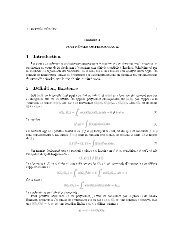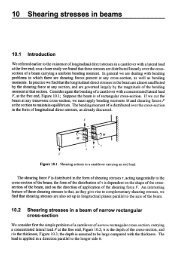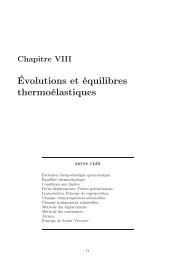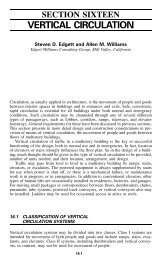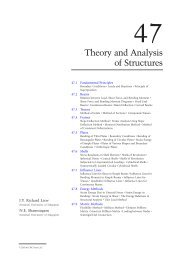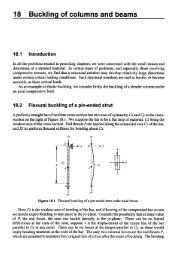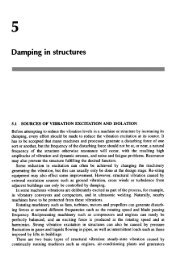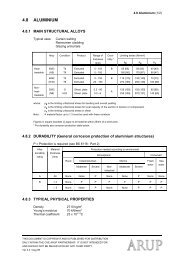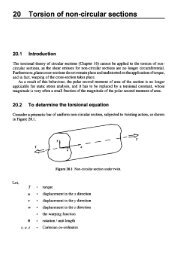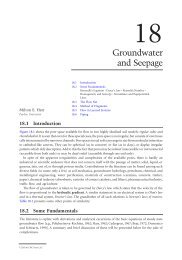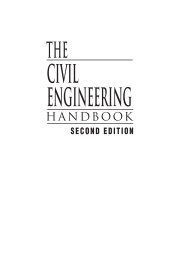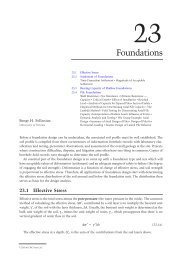Chapter 32 - Deep Foundations - Index of - Free
Chapter 32 - Deep Foundations - Index of - Free
Chapter 32 - Deep Foundations - Index of - Free
- No tags were found...
You also want an ePaper? Increase the reach of your titles
YUMPU automatically turns print PDFs into web optimized ePapers that Google loves.
• Rupture <strong>of</strong> active fault and shear zone• Landslide or ground instability• Difficult ground conditions such as underlying weak and compressible soils• Debris flow• Scour and erosion• Chemical corrosion <strong>of</strong> foundation materials• Weathering and strength reduction <strong>of</strong> foundation materials• <strong>Free</strong>zing• Water conditions including flooding, water table change, dewatering• Environmental change due to construction <strong>of</strong> the bridge• Site contamination condition <strong>of</strong> hazardous materials• Effects <strong>of</strong> human or animal activities• Influence upon and by nearby structures• Governmental and community regulatory requirements• Local practice<strong>32</strong>.3.6 Uncertainty <strong>of</strong> Foundation DesignFoundation design is as much an art as a science. Although most foundation structures are manmade,the surrounding geomaterials are created, deposited, and altered in nature over the geologictimes. The composition and engineering properties <strong>of</strong> engineering materials such as steel andconcrete are well controlled within a variation <strong>of</strong> uncertainty <strong>of</strong> between 5 to 30%. However, theuncertainty <strong>of</strong> engineering properties for natural geomaterials can be up to several times, evenwithin relatively uniform layers and formations. The introduction <strong>of</strong> faults and other discontinuitiesmake generalization <strong>of</strong> material properties very hard, if not impossible.Detailed geologic and geotechnical information is usually difficult and expensive to obtain.Foundation engineers constantly face the challenge <strong>of</strong> making engineering judgments based onlimited and insufficient data <strong>of</strong> ground conditions and engineering properties <strong>of</strong> geomaterials.It was reported that under almost identical conditions, variation <strong>of</strong> pile capacities <strong>of</strong> up to 50%could be expected within a pile cap footprint under normal circumstances. For example, piles withina nine-pile group had different restruck capacities <strong>of</strong> 110, 89, 87, 96, 86, 102, 103, 74, and 117 kips(1 kip = 4.45 kN) respectively [19].Conservatism in foundation design, however, is not necessarily always the solution. Under seismicloading, heavier and stiffer foundations may tend to attract more seismic energy and produce largerloads; therefore, massive foundations may not guarantee a safe bridge performance.It could be advantageous that piles, steel pipes, caisson segments, or reinforcement steel bars aretailored to exact lengths. However, variation <strong>of</strong> depth and length <strong>of</strong> foundations should always beexpected. Indicator programs, such as indicator piles and pilot exploratory borings, are usually agood investment.<strong>32</strong>.4 Axial Capacity and Settlement — Individual Foundation<strong>32</strong>.4.1 GeneralThe axial resistance <strong>of</strong> a deep foundation includes the tip resistance ( ), side or shaft resistance( Q side), and the effective weight <strong>of</strong> the foundation ( W pile). Tip resistance, also called end bearing, isthe compressive resistance <strong>of</strong> soil near or under the tip. Side resistance consists <strong>of</strong> friction, cohesion,and keyed bearing along the shaft <strong>of</strong> the foundation. Weight <strong>of</strong> the foundation is usually ignoredQ end© 2000 by CRC Press LLC



